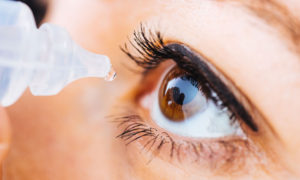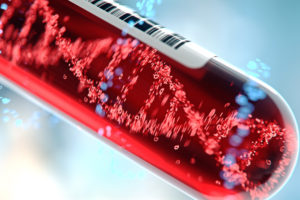Bay Biosciences provides high-quality, fresh frozen samples, matched fresh frozen sera (serum), plasma, and peripheral blood mononuclear cells (PBMC) bio-fluids from patients diagnosed with thyroid eye disease (TED).
The sera (serum), plasma and PBMC bio-fluid specimens are processed from thyroid eye disease (TED) patient’s peripheral whole-blood using customized collection and processing protocols.
Fresh frozen biopsy tissue samples and matched bio-fluids are collected from unique patients diagnosed with thyroid eye disease (TED).

Thyroid Eye Disease (TED) Overview
Thyroid eye disease (TED), also known as Graves’ eye disease or Graves’ ophthalmopathy, is an inflammatory condition in patients with thyroid disease. Treatment may include medication, eye drops, and surgery.
People with thyroid eye disease have dry, painful, inflamed eyes. Without treatment, it may cause complications such as bulging eyes and double vision.
Thyroid eye disease is most common in people with Graves disease, a type of hyperthyroidism. It can also occur in people with other types of hyperthyroidism. Less commonly, it occurs in people with hypothyroidism, which is an underactive thyroid.
Treatment focuses on managing thyroid disease and then treating the eye symptoms. In most cases, conservative treatment with lubricating eye drops helps with symptoms. However, some patients need corticosteroids or other medication. About 2 in 10 patients with thyroid eye disease will need surgery.
Causes of Thyroid Eye Disease (TED)
The immune system usually produces proteins known as antibodies in order to fight against foreign invaders like viruses and bacteria.
If you have an autoimmune disease like Graves’ disease, though, your immune system begins to fight against healthy tissues and cells in your body.
With Graves’ disease, instead of producing antibodies to target a specific invader, your immune system mistakenly produces thyroid-stimulating immunoglobulins. These antibodies then target your own healthy thyroid cells.
Scientists know that people can inherit the ability to make antibodies against their own healthy cells. But they have yet to find a clear cause of Graves’ disease or determine who will develop it.
Experts believe it’s possible that your genes and a virus or other external trigger both play a part in its development.
Doctors do not fully understand what causes TED, nor why some people with thyroid disease develop it and others do not. Thyroid disease can cause the body’s immune system to attack healthy tissue.
- Antibodies: Over time, a group of antibodies — anti-thyrotropin receptor antibodies, accumulate in the eye. Their presence causes pain and inflammation. The number of these antibodies correlates with the severity of TED symptoms.
- Hyperthyroidism: 9 in 10 people with TED have hyperthyroidism. 3 in 100 have Hashimoto’s disease, an autoimmune form of hypothyroidism.
- Immune cells: Researchers believe that the same immune cells that attack the thyroid to cause thyroid diseases, such as Graves’ disease, also attack body fat and other tissues around the eyes, especially a group of cells known as orbital fibroblasts.
- Smoking: Research shows that smoking is a significant risk factor for developing TED and for more severe cases of the condition.
Risk Factors of Thyroid Eye Disease (TED)
A few different factors may affect your chance of developing Graves’ disease:
- Age
- Genetics (family history of the condition)
- Stress
- Gender
The disease typically develops in people younger than 40. Your risk also increases significantly if any family members have Graves’ disease. The NIDDK says that women develop it 7 to 8 times more frequently than men.
Your risk also increases if you have another autoimmune disease. Examples include:
Diagnosis of Thyroid Eye Disease (TED)
Doctors usually diagnose TED based on symptoms. Most people with this condition also have a retraction of their eyelids, so a doctor may look for this sign.
In a person with new eye symptoms, a doctor may recommend bloodwork to test thyroid function. They will also ask about symptoms, examine the eyes, and ask about the history of symptoms.
In some cases, a doctor may recommend imaging scans of the eye, such as a magnetic resonance imaging (MRI) or computed tomography (CT) scan. This enables a doctor to see internal structures and to look for other potential causes of eye pain pain.
Your doctor may request laboratory tests if they think you might have TED. If anyone in your family has had TED or Graves’ disease, your doctor may be able to narrow down the diagnosis based on your medical history and a physical examination.
They’ll still need to confirm the diagnosis through thyroid blood tests. A doctor who specializes in diseases related to hormones, known as an endocrinologist, may handle your tests and diagnosis.
Your doctor may also request some of the following tests:
- Thyroid-stimulating immunoglobulin testBlood test
- Thyroid ultrasound
- Radioactive iodine uptake test
- Thyroid-stimulating hormone test
The combined results of these may help your doctor learn if you have TED or another type of thyroid disorder.
Treatment of Thyroid Eye Disease (TED)
TED is an inflammatory condition of the eyes that occurs when antibodies that attack the thyroid also attack the eye. Between 25% and 50% of people with Graves’ hyperthyroidism develop this symptom.
Medications
Most people get better with a two-pronged approach — treating the underlying thyroid disease and conservative management of eye symptoms. This usually means taking medication to treat the thyroid and using lubricating eye drops to reduce pain and inflammation in the eye.
A relatively new drug, teprotumumab-trbw, may also help. This drug blocks the activity of the insulin-like growth factor 1 receptor. Doctors believe this protein plays a role in the development of TED.
Steroids
In more severe cases that do not respond well to conservative treatment, a person may need to take a corticosteroid such as prednisone. These drugs weaken the immune reaction that in this case causes the body to attack the eyes and may reduce or even eliminate symptoms.
However, they also cause side effects and can weaken the immune system, so it is important for a person to try other treatments first.
Surgery
Several different surgeries may reduce pressure and inflammation in the eyes. The most common is orbital decompression. Pressure on the optic nerve is usually the reason why surgery may be necessary.
Orbital decompression removes a portion of the bone between the eye socket and sinuses, creating more space for the eye muscles, so they do not press on other structures. This may reduce bulging and pressure.
In some cases, a doctor may recommend surgery on the eyelid. Strabismus surgery, which can help stabilize the eye muscles, may also help if orbital decompression does not work.
Surgery may also treat some of the appearance changes TED can cause, such as bulging eyes.
Psychological Support
TED may change the way the eyes and face look. This can be scary and may even cause depression or affect relationships. Mental health support from a therapist or a support group can help.
It is also important to develop a plan to manage stress. This is because stress may make TED symptoms worse or reactivate TED when it is in remission.
Hyperthyroidism Treatment
Hyperthyroidism treatment manages symptoms as well as treating the thyroid itself. Symptom management may include interventions such as eye drops or medication for anxiety and heart palpitations.
To prevent the thyroid gland from producing too much thyroid hormone, a few treatment options are available:
- Radioactive iodine therapy
- Surgical removal of all or part of the thyroid, also known as a thyroidectomy
- Thionamide treatment
Outlook
With treatment, the outlook for TED is excellent. Approximately 8 in 10 people with TED need only conservative treatment with eye drops. About 2 in 10 will need surgery. In about 5% of cases, a person may need immunomodulation therapy or steroid treatment.
While the outlook is good, TED can affect mental health and self-image, especially when it changes the appearance of the eyes and face. It may also cause ongoing painful flares. Social and psychological support are important.
When to Contact a Doctor
A person should contact a doctor for any vision problems or ongoing eye pain. People with a history of thyroid disease should see a doctor for dry eyes, eye pain, or vision changes, even if their thyroid disease is well-managed and in remission.
Treating TED may help prevent complications.
Summary
Thyroid eye disease can be very painful. It may make reading, looking at a computer, and other daily tasks unpleasant. It can also affect a person’s vision and, by extension, daily functions such as driving and hobbies.
TED responds well to treatment. Even when conservative treatment fails, several other treatments can reduce symptoms and prevent additional damage to the eye.

Bay Biosciences is a global leader in providing researchers with high quality, clinical grade, fully characterized human tissue samples, bio-specimens, and human bio-fluid collections.
Samples available include cancer (tumor) tissue, cancer serum, cancer plasma, cancer, peripheral blood mononuclear cells (PBMC). and human tissue samples from most other therapeutic areas and diseases.
Bay Biosciences maintains and manages its own biorepository, the human tissue bank (biobank) consisting of thousands of diseased samples (specimens) and from normal healthy donors available in all formats and types.
Our biobank procures and stores fully consented, deidentified and institutional review boards (IRB) approved human tissue samples and matched controls.
All our human tissue collections, human specimens and human bio-fluids are provided with detailed, samples associated patient’s clinical data.
This critical patient’s clinical data includes information relating to their past and current disease, treatment history, lifestyle choices, biomarkers, and genetic information.
Patient’s data is extremely valuable for researchers and is used to help identify new effective treatments (drug discovery & development) in oncology, and other therapeutic areas and diseases.
Bay Biosciences banks wide variety of human tissue samples and biological samples, including cryogenically preserved at – 80°C.
Including fresh frozen tissue samples, tumor tissue samples, formalin-fixed paraffin-embedded (FFPE), tissue slides, with matching human bio-fluids, whole blood and blood-derived products such as serum, plasma and PBMC.
Bay Biosciences is a global leader in collecting and providing human tissue samples according to the specified requirements and customized, tailor-made collection protocols.
Please contact us anytime to discuss your special research projects and customized human tissue sample requirements.
Types of Biospecimens
Bay Biosciences provides human tissue samples (human specimens) from diseased and normal healthy donors which includes:
- Peripheral whole-blood
- Amniotic fluid
- Bronchoalveolar lavage fluid (BAL)
- Sputum
- Pleural effusion
- Cerebrospinal fluid (CSF)
- Serum (sera)
- Plasma
- Peripheral blood mononuclear cells (PBMC)
- Saliva
- Buffy coat
- Urine
- Stool samples
- Aqueous humor
- Vitreous humor
- Kidney stones (renal calculi)
- Other bodily fluids from most diseases including cancer.
We can also procure most human bio-specimens, special collections and requests for human samples that are difficult to find. All our human tissue samples are procured through IRB-approved clinical protocols and procedures.
In addition to the standard processing protocols, Bay Biosciences can also provide human plasma, serum, and PBMC bio-fluid samples using custom processing protocols; you buy donor-specific collections in higher volumes and specified sample aliquots from us.
Bay Biosciences also provides human samples from normal healthy donors; volunteers, for controls and clinical research, contact us Now.
- 日本のお客様は、ベイバイオサイエンスジャパンBay Biosciences Japanまたはhttp://baybiosciences-jp.com/contact/までご連絡ください。
